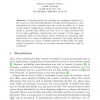Free Online Productivity Tools
i2Speak
i2Symbol
i2OCR
iTex2Img
iWeb2Print
iWeb2Shot
i2Type
iPdf2Split
iPdf2Merge
i2Bopomofo
i2Arabic
i2Style
i2Image
i2PDF
iLatex2Rtf
Sci2ools
89
Voted
BNCOD
2008
2008
An Empirical Study of Utility Measures for k-Anonymisation
Abstract. k-Anonymisation is a technique for masking microdata in order to prevent individual identification. Besides preserving privacy, data anonymised by such a method must also retain its utility, i.e. it must remain useful to applications. Existing k-anonymisation methods all attempt to optimise data utility, but they do so by using measures that do not take application requirements into account. In this paper, we empirically study several popular utility measures by comparing their performance in a range of application scenarios. Our study shows that these measures may not be a reliable indicator of data utility for applications in practice, and how to use these measures effectively must be considered.
Related Content
| Added | 29 Oct 2010 |
| Updated | 29 Oct 2010 |
| Type | Conference |
| Year | 2008 |
| Where | BNCOD |
| Authors | Grigorios Loukides, Jianhua Shao |
Comments (0)

